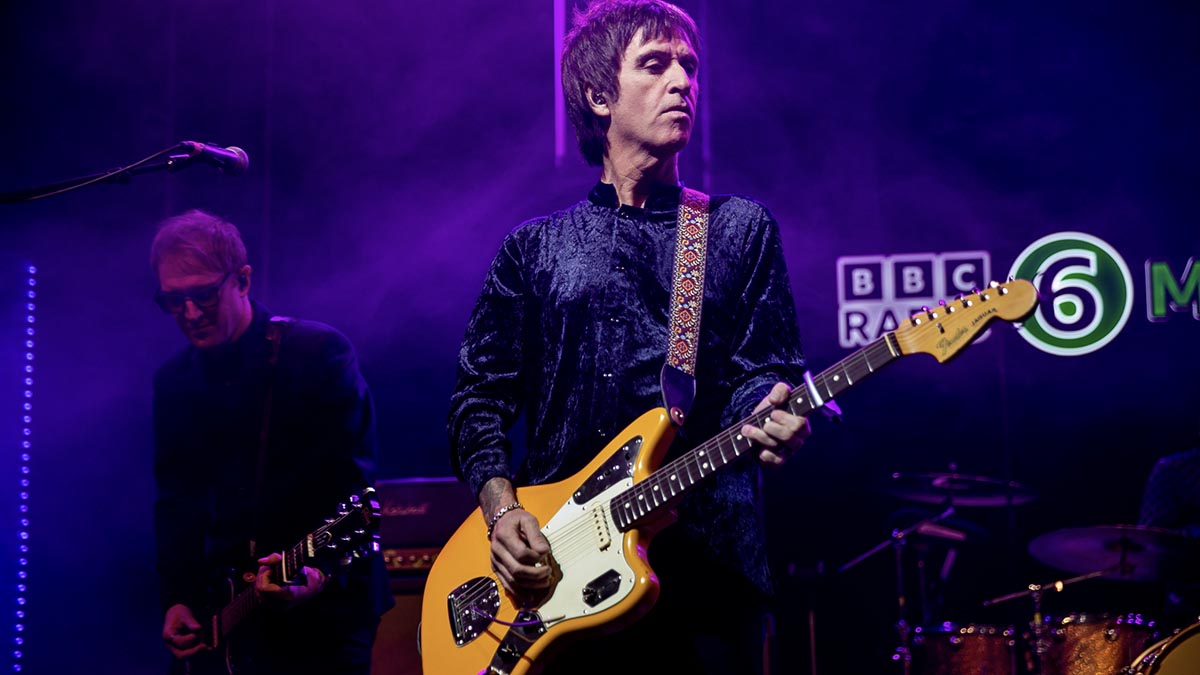Learn Johnny Marr’s rhythm guitar secrets
From the sophisticated slash chords sounds of The Smiths to funky two-note dyads and capo’d strums, Marr’s playing style is a feast of different techniques and approaches

He’s the Smiths guitar wizard who inspired a legion of indie guitarists to experiment with jangly tones. And, from the Madchester scene and 90s Britpop to later acts like The Killers, The Decemberists and The Drums, Johnny Marr’s influence is truly lasting.
Notably, he’s created his legacy without languishing in one band for four decades – Marr’s influence comes from the breadth of his career’s work with acts such as The The, Electronic, Modest Mouse, The Cribs, and in more recent years as a solo artist.
Here, we’re looking at some key elements of Johnny’s playing style; parts of his playing that were at the core of the sound of The Smiths in the 80s, right up to today’s solo work. Our tab examples showcase some of the technical and compositional approaches Johnny has used over the years.
Work through at your own pace and appreciate the magic...
Example 1. Sophisticated chords: Slash chords

Johnny Marr is a fan of using rich sounding chords in his arrangements, such as the C/F slash chord here – it’s a C major chord over an F bass note.
F doesn’t appear in the C chord (the notes are C, E and G), so you can be sure you’re adding colour to the sound of the basic chord. To record our part we used a 12-string electric guitar, inspired by Johnny’s use of the Rickenbacker 360-12.
Example 2. Sophisticated chords: Extended major chords

This example showcases a great way to play the major 9 chord sound, but listen out too for those dips on the tremolo arm, which are key to the sound.
We used a trem-quipped Gretsch but Johnny is better known for his Bigsby-loaded Gibson ES-355, which featured on tracks such as The Smiths’ Heaven Knows I’m Miserable Now.
Example 3. Sophisticated chords: Major 7ths & minor 9ths

Here we’re using one chord shape in two different contexts. Firstly we play the shape at the 12th fret with the bass guitar playing an E note, creating an Em9. Then the shape is played at the 7th fret over a D bass note to give a Dmaj7 sound. It’s a trick Johnny used in The Smiths’ I Don’t Owe You Anything.
Example 4. Acoustic strumming

Johnny has a great rhythmic sense, and songs like Bigmouth Strikes Again by The Smiths or Hi Hello from Marr’s Call The Comet 2018 solo album feature strummed acoustic parts.
The galloping rhythm here features on many The Smiths songs; the open strings help create continuity between the chords and add to the ringing jangle.
Example 5. 2nd fret capo

In this example, we add a simple electric guitar line over our strummed acoustic example – similar to Marr’s work on The Smiths’ Back To The Old House or This Tension from his 2014 Playland solo album. Use alternate picking and make sure the strings ring out constantly.
Example 6. 2nd fret capo

In some recording sessions with The Smiths, Marr would tune his guitar up by a tone to F# standard tuning (F# B E A C# F#). Obviously a capo at the 2nd fret is the more practical choice for the sake of experimenting.
Our example is inspired by 2nd-fret capo songs like Barbarism Begins At Home and This Night Has Opened My Eyes.
Example 7. Fuzzy tones

There are several The Smiths songs such as What Difference Does It Make and Sheila Take A Bow that feature fuzz distortion tones, in addition to more recent songs like Tenement Time. Our example has a shuffle feel, so all of the eighth notes are slightly swung. The open strings provide sustain, ringing out to provide a denser texture.
Example 8. Funky partial chords

For this example, we’re embellishing the acoustic guitar foundation we laid down in Example 6. Johnny’s two-note chord approach can be heard on Smiths tracks such as This Charming Man and Meat Is Murder. The main consideration here is to maintain the muting of the open strings with your idle fretting fingers.
Example 9. Layering parts 1: Jangle chords

Marr is known for his multi-tracked soundscapes with layered guitar parts. For our example we started by double-tracking an acoustic guitar part with a 2nd-fret capo. The next layer is notated here and consists of simple spread chords played on a 12-string electric guitar with a capo on the 2nd fret. The idea is to add to the track, but still leave enough space for the next layer.
Example 10. Layering parts 2: Doublestops and harmonics

Inspired by Cemetry Gates and This Charming Man, we’re adding another layer to the previous part here with a simple motif using doublestops and natural harmonics.
Get The Pick Newsletter
All the latest guitar news, interviews, lessons, reviews, deals and more, direct to your inbox!
Jon Bishop is a UK-based guitarist and freelance musician, and a longtime contributor to Guitar Techniques and Total Guitar. He's a graduate of the Academy of Contemporary Music in Guildford and is touring and recording guitarist for British rock 'n' roll royalty Shakin’ Stevens.









![Joe Bonamassa [left] wears a deep blue suit and polka-dotted shirt and plays his green refin Strat; the late Irish blues legend Rory Gallagher [right] screams and inflicts some punishment on his heavily worn number one Stratocaster.](https://cdn.mos.cms.futurecdn.net/cw28h7UBcTVfTLs7p7eiLe.jpg)

